The Mummy; Drag Me to Hell
By Matt Brunson
Need some Halloween (or Friday the 13th) viewing suggestions? Here are 13 movies presently available for Amazon Prime subscribers to watch for free.
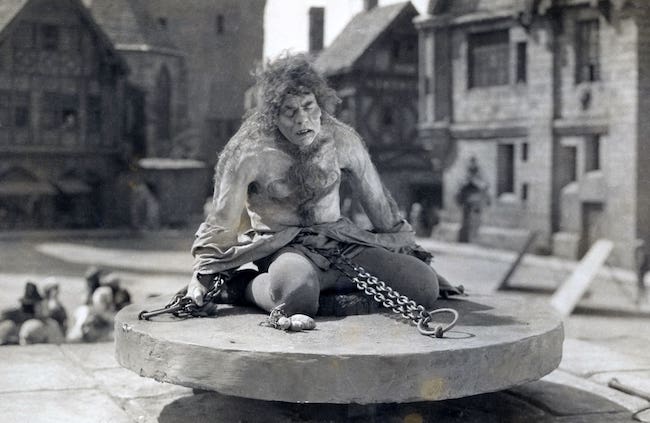
THE HUNCHBACK OF NOTRE DAME (1923). One of the greats of the silent era, Lon Chaney suffered for his art more than just about any other performer in film history. Armed with his own makeup kit, Chaney became so well-known for his radically different appearances that he earned the nickname “Man of a Thousand Faces” and further inspired the popular crack, “Don’t step on it; it might be Lon Chaney!” But his creations came at a price, as his makeup applications and physical contortions led to such enduring problems as poor eyesight and aching body parts. One of his most remarkable transformations can be seen in The Hunchback of Notre Dame, an expensive production that proved to be a box office blockbuster and turned the actor into a superstar. Chaney delivers a remarkable performance as Quasimodo, the misshapen Parisian bell-ringer who falls for the lovely gypsy Esmeralda (Patsy Ruth Miller). While it’s difficult to ascertain whether this film or the 1939 version starring Charles Laughton is the best adaptation of Victor Hugo’s novel, this is nevertheless an awe-inspiring achievement, featuring magnificent sets (built on the Universal backlot), the proverbial cast of thousands (the crowd scenes are mesmerizing), and an opportunity to catch Chaney at his most commanding.
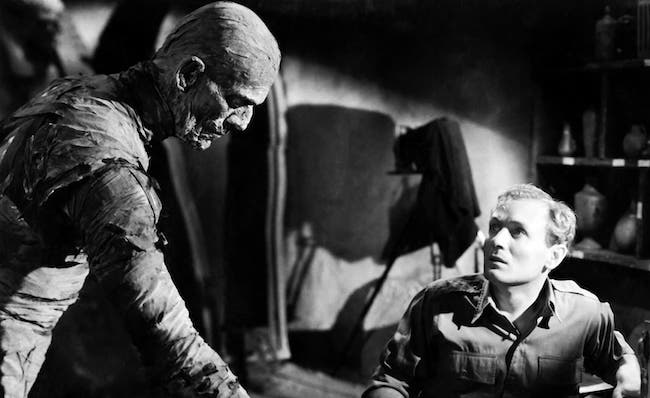
THE MUMMY (1932). It’s a real shame that when audiences today hear the word “mummy” in relation to cinema, they automatically think of that middling Brendan Fraser film and its imbecilic sequels (or, worse, that Godawful “Dark Universe” nonsense with Tom Cruise). This version is the real deal, as Universal, thrilled that it now had a name actor in Boris Karloff — thanks, of course, to 1931’s Frankenstein — immediately thrust him into another monster movie that would endure as a genre staple. Karloff was so well-known, in fact, that posters for The Mummy dropped his first name and simply billed him as “Karloff the Uncanny.” Karl Freund, the Oscar-winning cinematographer who had cut his teeth working on German expressionism flicks back in his home country during the silent era, had shot 1931’s Bela Lugosi classic Dracula for the studio and was thus allowed to sit in the director’s chair for this one. His feel for pervasive atmosphere is one of the greatest strengths in this yarn about the efforts of the revived Egyptian priest Im-Ho-Tep (Karloff) to locate the resurrection of his beloved princess (Zita Johann). The formidable makeup designs again came courtesy of the proficient Jack Pierce, Universal’s brilliant go-to guy (Frankenstein, The Wolf Man, etc.).
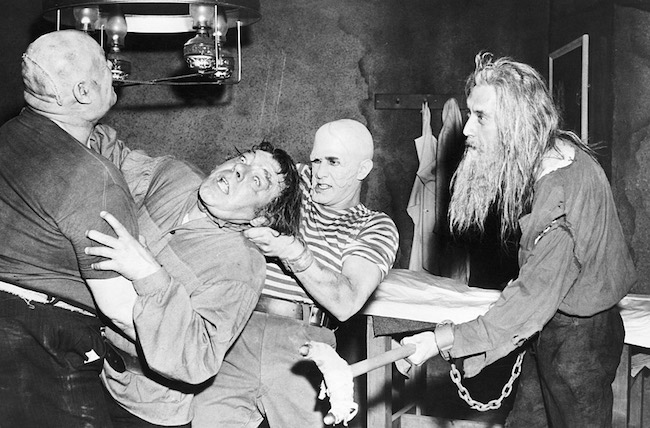
THE BLACK SLEEP (1956). A fantastic cast of horror all-stars is the chief selling point of The Black Sleep, although the film itself doesn’t live up to its marquee power. Basil Rathbone stars as Dr. Cadman, who’s conducting gruesome brain experiments on unwilling subjects provided by a purring gypsy (Akim Tamiroff, offering the comic relief in a role originally intended for Peter Lorre). Cadman’s manservants are among the botched results, and although Lon Chaney Jr. and Bela Lugosi essay these roles, their participation produces feelings of depression rather than elation: Both men were addicts at this point in their lives — Chaney with alcohol, Lugosi with drugs — and they’re handed thankless roles bereft of even one line of dialogue between them (Lugosi would pass away later in the year, but Chaney struggled until 1973). More enjoyable are fellow genre mainstays John Carradine and Tor Johnson, who appear all too briefly in the frenzied finale. The Black Sleep isn’t nearly as bad as its reputation, but a higher budget and a more accomplished director than Reginald LeBorg might have yielded a more respectable horror yarn.
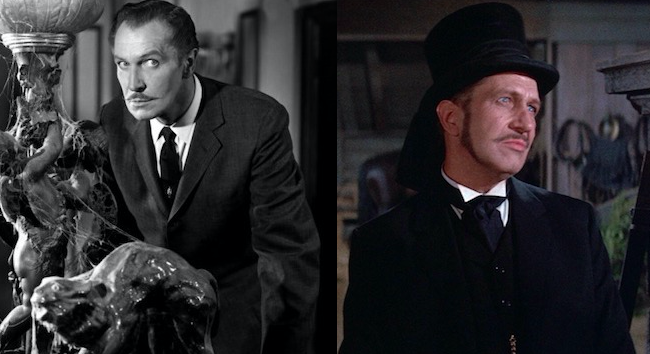
HOUSE ON HAUNTED HILL (1959) / THE COMEDY OF TERRORS (1964). Vincent Price and more Vincent Price? To (mostly) quote the horror superstar and erudite gentleman, “No mere mortal can resist the evil of the double-feature thriller!” One of director-producer William Castle’s most enjoyable flicks, House on Haunted Hill casts Price as an eccentric millionaire who offers five strangers $10,000 apiece to those who can survive a night at his haunted mansion. Upon its theatrical release, Castle employed a gimmick he dubbed “Emergo,” having a skeleton swoop over the auditorium to coincide with its appearance in the film. Even without this added benefit, couch viewers will find themselves satisfied with the on-screen shenanigans. The Comedy of Terrors finds Price reunited with Peter Lorre and Boris Karloff, his co-stars in the same year’s The Raven, for a giddy romp directed by the perpetually underrated Jacques Tourneur (Cat People, Out of the Past). Price delivers a wondrous comic performances as Waldo Trumbull, an unscrupulous undertaker making life miserable for his wife Amaryllis (Joyce Jameson), his partner Felix Gillie (Lorre), and the clueless father-in-law (Karloff) he’s always trying to poison. Lorre’s pratfalls and the delicious verbiage written for Price and Karloff (the latter’s eulogy for a landlord played by Basil Rathbone is hilarious) make this a real treat.
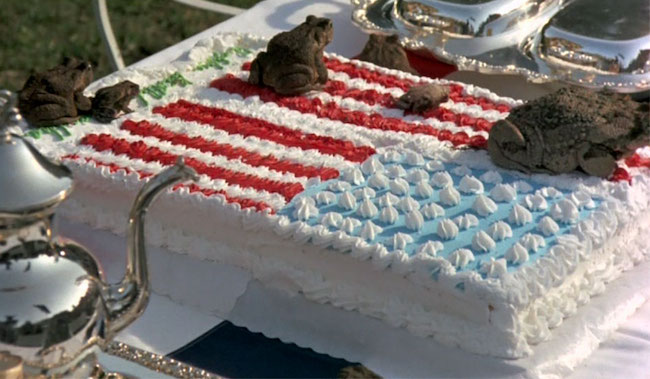
FROGS (1972). “Nature Run Wild” movies ran wild during the 1970s, with all manner of animals and insects slaughtering humans at every opportunity (often for their blatant disregard for the environment). Most of these films were junk — and 1976’s Food of the Gods scoots well beyond junk to firmly establish itself as one of cinema’s all-time worsts — but I’ve always had a soft spot for at least four efforts from this disreputable subgenre: 1977’s Kingdom of the Spiders (featuring William Shatner and a great ending), 1976’s Squirm (reviewed in the 2021 edition of Halloween Prime Cuts), 1979’s Prophecy (see below), and 1972’s Frogs. The last-named stars Ray Milland as Jason Crockett, a family patriarch who hates nature and so of course lives on an island estate completely surrounded by wildlife. The animal kingdom reacts negatively to the pollution caused by this millionaire and his family, so, under the leadership of the frogs, this leads to … Death by snake! Death by tarantula! Death by alligator! Even death by turtle! An imaginative premise, a solid cast — Sam Elliott as a hunky wildlife photographer; Joan Van Ark as the most sympathetic of Jason’s brood; Adam Roarke as Jason’s perpetually soused son — and a few surprisingly fresh characterizations lift this out of the mire.
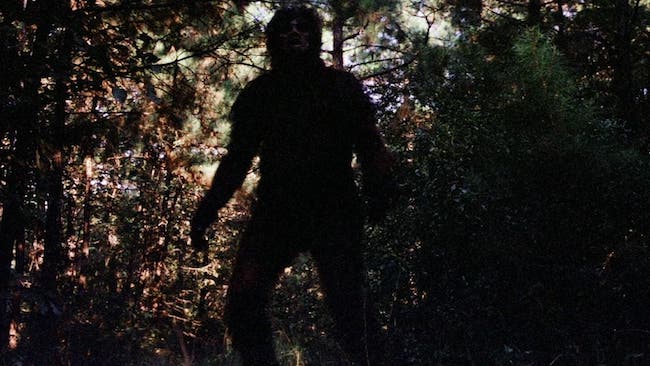
CREATURE FROM BLACK LAKE (1976). At first glance, Creature from Black Lake appears to be one of those exploitation-documentary hybrids that were so popular in the 1970s, movies like 1972’s The Legend of Boggy Creek, 1978’s Faces of Death, and 1979’s In Search of Historic Jesus (which Leonard Maltin hilariously opined “should be retitled In Search of Morons Who Will Believe Anything”). Yet it’s actually a more straightforward monster movie, and it’s all the better for it. Also known as Demon of the Lake, it centers on the efforts of two Chicago anthropology students (John David Carson and Dennis Fimple) to track down a hulking Bigfoot-like creature that’s rumored to be terrorizing the Louisiana swamps. For a low-budget effort from two regional filmmakers (director Joy N. Houck Jr. and writer Jim McCullough Jr.) and presumably aimed at the drive-in crowd, this is better than it has any right to be — the scene staging is occasionally clumsy and some of the dialogue is wince-inducing, but the film is skillfully shot (cinematographer Dean Cundey would later earn an Oscar nomination for Who Framed Roger Rabbit and also handle d.p. duties on hits like Jurassic Park and Apollo 13), Carson and Fimple are likable leads, and folksy veterans Jack Elam and Dub Taylor are on hand to add rural flavor.
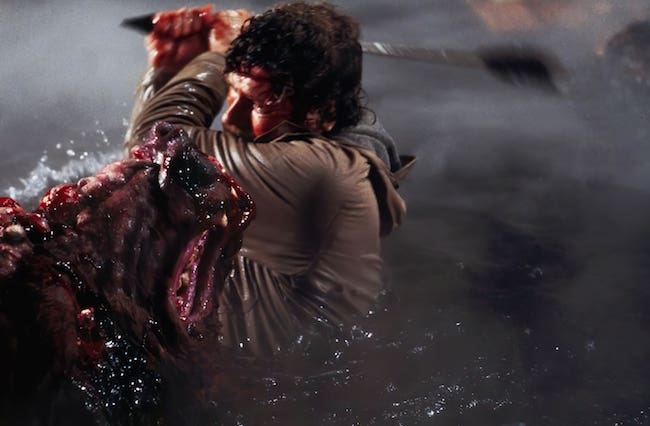
PROPHECY (1979). Given the title, it would be logical to assume that Prophecy was a sequel to The Omen — more so since both were written by David Seltzer — but instead of a satanic child, its antagonist is a mutant bear. A horror movie with an ecological twist, this stars Robert Foxworth as an EPA-sanctioned doctor who, with pregnant wife (Talia Shire) in tow, travels to Maine to investigate a dispute between the Native American community (represented by Armand Assante) and a lumber company (represented by Richard Dysart). It’s revealed that the lumber company has been dumping mercury into the water, and the pollution has resulted in various deformed and crazed critters. None, however, is as frightening as the mutated bear with a nasty habit of tearing humans apart. Many consider this the nadir of The Manchurian Candidate director John Frankenheimer’s career, but despite its occasional dopiness, I’ll take it in a heartbeat over the Ben Affleck starrer Reindeer Games and that truly bizarre Brando version of The Island of Dr. Moreau. The effects are often solid (although just as often not), and the narrative moves at a decent clip. Besides, those of us who first saw this in our youth — in my case, upon its original release at the age of 14 — have never forgotten that sleeping bag sequence.
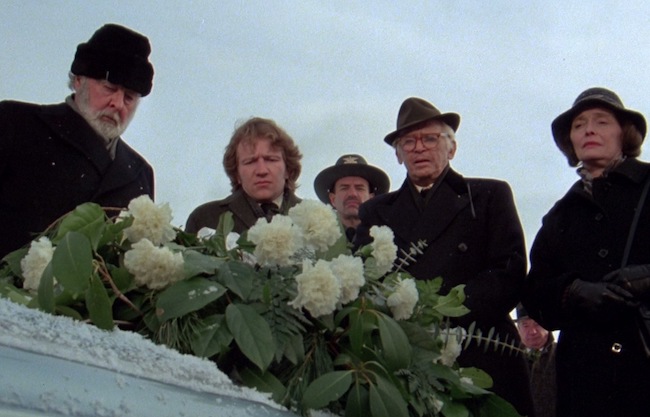
GHOST STORY (1981). Peter Straub’s massively successful novel gets streamlined for an OK film adaptation whose primary point of interest is its collection of superlative seniors in the leading roles. Octogenarians Fred Astaire and Melvyn Douglas and septuagenarians Douglas Fairbanks Jr. and John Houseman portray four lifelong friends whose staid existence in their New England hometown is uprooted by what appears to be a spectral entity seeking some sort of retribution. The son (Craig Wasson) of one of the elders is also drawn into the mystery, which seems to hinge on the presence of a beautiful if peculiar woman (Alice Krige). Director John Irvin has difficulty establishing any sort of mood, and scares are equally nonexistent. But the commitment of the fine cast (particularly Krige) and the picture’s smooth use of flashbacks marginally help elevate the proceedings. And, again, the opportunity to see this quartet of legendary actors appearing together is catnip to cinema lovers — after all, that’s 313 years between the four of them! This proved to be the final theatrical feature for Astaire, Douglas, and Fairbanks.
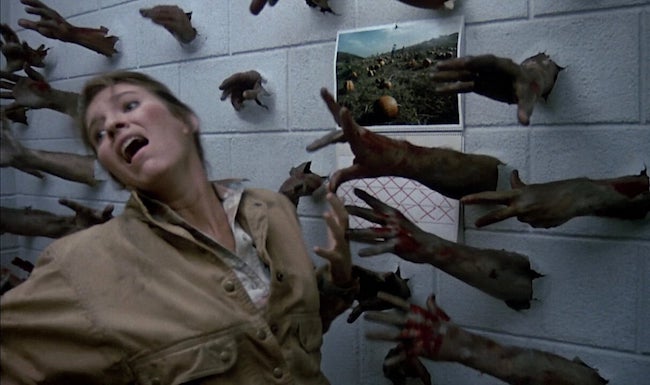
DAY OF THE DEAD (1985). George Romero’s 1968 Night of the Living Dead has long been considered a classic, as has its 1978 sequel Dawn of the Dead. As for this third installment — well, it’s considered anything but a classic, yet it’s slowly gaining a better reputation than the middling one it received upon its original release, when it quickly became apparent that this was the runt of its particular cinematic litter. Set in an underground military bunker, this finds a group of scientists, intent on studying the zombies in the hopes of finding a cure, engaged in a mental tug-of-war with the trigger-happy soldiers who would be just as content wiping out everybody (scientists and zombies alike) who vexes them. Largely missing is the primal horror of the first film and the sharp satire of the second, yet what remains isn’t bad at all, with some of Romero’s interesting ideas and Tom Savini’s gory effects triumphing over some amateurish acting (major exception: Howard Sherman, who’s effective, even touching, as Bub the domesticated zombie). Interestingly, this movie shares the same philosophy as 2002’s considerably more acclaimed zombie flick 28 Days Later: A flesh-eating monster may be nobody’s idea of a desirable companion, but he’s no worse than a spirit-sapping military man.
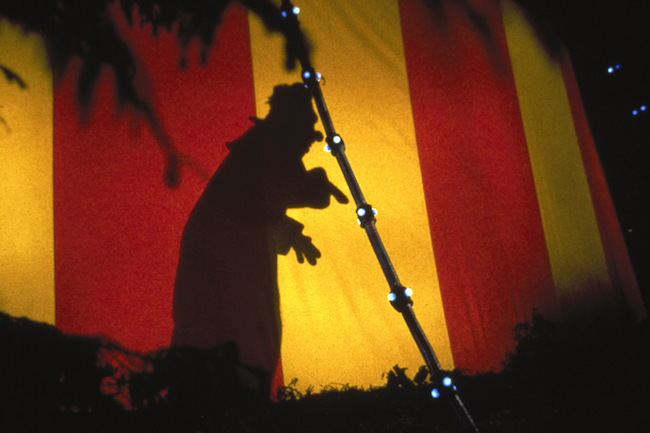
KILLER KLOWNS FROM OUTER SPACE (1988). Although the Chiodo Brothers — Stephen, Charles, and Edward — have helped create the visual effects seen in various Hollywood flicks over the decades (credits include Critters, Elf, and Team America: World Police), only once have they been handed the reins to write, direct, and produce their own theatrical motion picture. That would be Killer Klowns from Outer Space, and, given the groovy results, it’s a mystery why we’ve now gone 35 years without some studio handing them the funds to make another movie. Working wonders with a relatively slender budget, the siblings serve up an endlessly inventive yarn in which a small town is invaded by otherworldly Bozos who begin capturing, killing, and cocooning the citizens for future consumption. Clean-cut kids Mike (Grant Cramer) and Debby (Suzanne Snyder) try to warn the local law, but while Debby’s ex-boyfriend, Deputy Dave (John Allen Nelson), suspects they might be telling the truth, grouchy Deputy Mooney (John Vernon, scowling as much as he did as Dean Wormer in National Lampoon’s Animal House) thinks it’s all a big hoax. The imagination that went into the visual effects, the set design, and the alien gadgetry makes it easy to overlook any minor deficiencies in other departments.
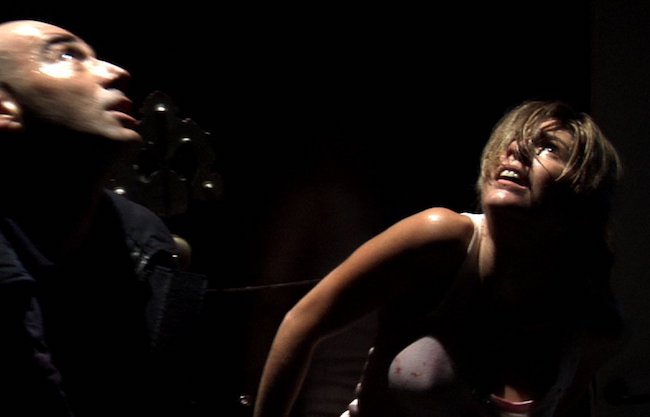
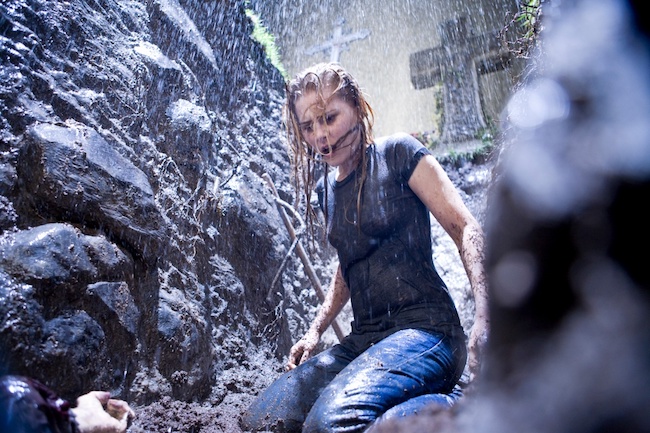
DRAG ME TO HELL (2009). Torture porn was quite popular during the late 2000s, which makes Drag Me to Hell such a welcome relief — it’s a funhouse freak show more interested in delivering old-fashioned thrills than in wallowing in misogyny, masochism, and mutilation. The story is so thin that it could have been written on a bubble gum wrapper, yet the end result is so delirious in its desire to delight that viewers willing to be jerked around won’t mind. Director Sam Raimi regains the playful prankster attitude he exhibited back in his Evil Dead days, crafting (with brother Ivan) this yarn about sweet-natured loan officer Christine Brown (Alison Lohman), who, in an ill-advised attempt to show her boss (David Paymer) that she’s able to make the “tough decisions,” denies Mrs. Ganush (Lorna Raver) a third extension on a loan, thus leaving the elderly woman homeless. Angered, the gypsy places a curse on Christine, a jinx that will expose her to three days of misery before she’s … well, check out that title. Drag Me to Hell isn’t exactly scary, and the climactic twist is telegraphed far too early in the narrative. But Lohman is ideally cast as a basically decent person who must make some hard calls if she wants to survive, and the brothers Raimi get a lot of mileage out of Mrs. Ganush as a formidable adversary.





